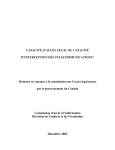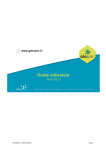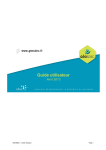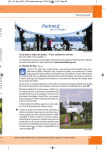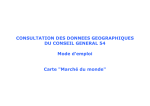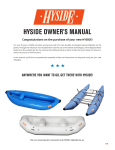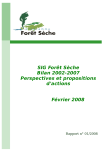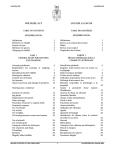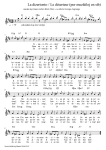Download User's Guide
Transcript
User’s Guide Choice of Internet browser While there are many browsers available on the Internet, some work better than others for this application. We recommend the following browsers to ensure best viewing: - Firefox - Google Chrome - Internet Explorer 9 and up Navigation Moving around in a View With this Web application you can move around in a view to the location you wish to see. The mouse pointer allows you to change your - Left click and hold - Move mouse to desired location - Release location. Zoom You can also use Zoom to pan in or pan out using the pointer or the zoom buttons. Pointer Place the pointer on the desired location and use the mouse ball to zoom in or out. Zoom in Zoom out User’s Guide This document is not legally binding. 1 Bookmarks (Géosignets) The Bookmarks tool takes you automatically to the location selected. This tool offers eight shortcuts to the following views: Note: Unité de gestion 071 Unité de gestion 072 Unité de gestion 073-074 TFS sud-est TFS sud-ouest TFS centre TFS centre-nord TFS nord-est Unité de gestion = management unit TFS = structured wildlife territory (ZECs, outfitters, Wildlife Reserves) Click on Bookmarks and choose the view you want. Each of the TFS views mentioned above will display a group of structured wildlife territories based on the compass points (north, south, east, west) as indicated in the view name. To exit, click on Bookmarks in the tool bar. Searching by Place Name The Search tool lets you find a place using the name of a lake, river or municipality. As you type the name, a list of choices will appear. Select the place you are looking for from the scroll down list. The view will be positioned on the chosen location and a label will appear on the map. Please note that you cannot search to find an element of a layer in the mapping application such as a ZEC, protected area or forestry operations site. User’s Guide This document is not legally binding. 2 Viewing Data When you open the map tool, all layers are, by default, activated. However, only two are visible. As you zoom in, different layers will appear depending on the scale of the map. Layers (Couches) At any time, the user can choose the layers of information they wish to display. Clicking on Layers allows access to a list of choices and you can choose what you want displayed using the checkmarks. When finished, click on Layers in the toolbar to exit. Information on Graphic Elements In addition to containing graphic elements (point, line or polygon), layers also contain data. At any time, you can select an element of the layer displayed on the screen and access information from the database. Highlight a graphic element by clicking on it and a small window containing the requested information will appear. In certain cases, a number of layers of information may superimpose themselves. In the following example, the two layers are superimposed (1 of 2): Programmation annuelle (PRAN) com (Annual Plan – commercial) and SIP com version antérieure (Sectors of Potential Commercial Interest – previous version). To see the data for the second layer, click on . User’s Guide This document is not legally binding. 3 Legend (Légende) Clicking on the Legend button will take you to the key for the symbols displayed on each map layer. Print (Imprimer) A number of printing formats are available with the Print tool. The arrow towards the bottom allows you to choose the paper size and format. The most common formats are: Letter ANSI A Landscape = 8½ x11 Landscape Letter ANSI A Portrait = 8½ x11 Portrait Tabloid ANSI B Landscape = 11 x17 Landscape Tabloid ANSI B Portrait = 11 x17 Portrait Note that there is a delay between the time you choose a format and the production of the map for printing. The message on the Print box will change to Printing in progress. User’s Guide This document is not legally binding. 4 Once the map is ready for printing, the message will change from Printing in progress to Printing. CTRL P will open the printing dialogue box and allow you to choose a printer and begin printing. Measure (Mesurer) Clicking on Measure gives you access to three calculating tools: the area of a polygon a distance the coordinates of a location For each tool you can select the desired unit of measurement. First, choose the tool you want then click on your preferred unit of measurement. To exit this tool, click on Measure in the tool bar. Basemap (Fond de carte) A basemap is a type of map view. Google Map offers nine basemaps, each with different visual characteristics. These basemaps do not contain data and are not interactive. To exit this tool, click on Basemap in the tool bar. User’s Guide This document is not legally binding. 5 Glossary of layers Aire de confinement du cerf de virginie/White-tailed Deer Yard Wooded area measuring at least 250 ha where white-tailed deer gather during the winter. These areas are protected under the Act respecting the conservation and development of wildlife. Aire protégée 6 /Protected areas By definition in the Natural Heritage Conservation Act, a protected area is “a geographically defined expanse of land or water established under a legal and administrative framework designed specifically to ensure the protection and maintenance of biological diversity and of related natural and cultural resources.” In the Outaouais there are 7 types of protected areas: - Aquatic reserve - Ecological reserve - Biodiversity reserve - Quebec national park - Biological refuge - National Capital Commission Park (Canada) - Exceptional forest ecosystem PRAN autre infrastructure4 / Annual Plan - Other Infrastructure Plan for the current year for work related to forestry operations (aggregate pit management or work camp). PRAN chemin 4 /Annual Plan - Roads Plan for the current year for forestry roadwork (construction, maintenance, upgrading). PRAN infrastructure 4 /Annual Plan - Infrastructure Plan for the current year for work involving bridges (construction, maintenance, upgrading). PRAN non commercial 4 /Annual Plan - Non-commercial Plan for the current year for sectors where non-commercial silvicultural work is to be carried out: replanting, brushing, site preparation. User’s Guide This document is not legally binding. 6 Programmation annuelle (PRAN) com 4 /Annual Plan - Commercial Plan for the current year of sectors where forest harvesting will take place. Réseau routier stratégique 5 /Strategic Road Network Principal public land access roads whose repair and maintenance has been prioritized by regional consensus. Secteur intervention potentiel (SIP) com 4 /Potential Intervention Sector - Commercial Potential intervention sector within which forestry operations may be planned in the coming years. Sentier récréatif (randonnée, portage, ski de fond...) 5 /Recreational Trail: Hiking, portage, skiing Authorized non-motorized recreational trails on public land. Sentier véhicule hors route (VHR) 5 /Off road vehicle trail Authorized quad and snowmobile trails on public land. SIP chemin commercial (com) 4 /Potential Intervention Sector - Roads Roadwork (construction, maintenance, upgrading) that may be planned and carried out in the coming years. SIP infrastructure com 4 /Potential Intervention Sector - Infrastructure Bridge work (construction, maintenance, upgrading) that may be planned and carried out in the coming years. SIP non commercial 4 /Potential Intervention Sector – Non-commercial Sector within which non-commercial silvicultural work may be planned and carried out in the coming years: replanting, brushing, site preparation. Site faunique d’intérêt (SFI) 1 /Site of interest – Wildlife A defined location containing one or more biological or physical elements favourable to the maintenance or development of wildlife that, by its biological or social value, is considered exceptional in a local or regional context. User’s Guide This document is not legally binding. 7 Territoire d’intérêt projeté 3 /Future site of interest A territory that has no legal status but is projected to be accorded protection by the government and, eventually, legal status. In the Outaouais, this may be: - A territory of interest for the creation of a biodiversity reserve - A future designation as an exceptional forest ecosystem - A future wildlife refuge Territoires fauniques structurés (TFS) 2 /Structured Wildlife Territories A legally defined area with controlled access. These territories are protected under the Act respecting the conservation and development of wildlife. The goal of this Act is the conservation of wildlife and its habitat, their development in keeping with the principle of sustainable development, and the recognition of every person's right to hunt, fish and trap in accordance with the law. In the Outaouais, 4 types of wildlife territories are identified in this application, as they are the most common and/or largest in area. These are: - Community Wildlife Area Outfitter with exclusive rights Wildlife reserve Controlled hunting/fishing zone (ZEC). Usage ponctuel 5 /Limited Use Type of rights or equipment that may be granted to a permit holder on public land. Source 1. Ministry of Natural Resources and Wildlife, 2009 Ministry of Sustainable Development, Environment and Parks, 2009 3. Ministry of Natural Resources and Wildlife, 2012 4. Ministry of Natural Resources, 2013 5. Ministry of Natural Resources, 2014 6. Ministry of Sustainable Development, Environment, Wildlife and Parks, 2014 2. User’s Guide This document is not legally binding. 8








